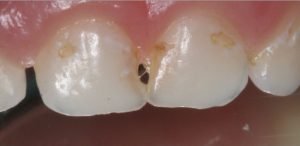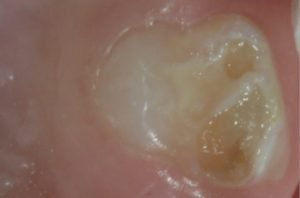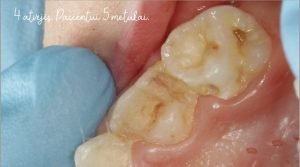Pediatric dentistry
Children’s dental treatment is a sensitive and complex procedure for both the child and the parents. Treatment can only be avoided by regular visits to a pediatric dentist. We also perform treatment with sedation and general anaesthesia.
L E A R N M O R E →
1/ Dentists
3/ First visit to the pediatric dentist
4/ It is important to find a good pediatric dentist
5/ Prices of dental services for children
6/ Sedation as a help to treat children’s dental diseases
7/ Do you need to protect milk teeth?
8/ Dental sealants – what are they?
Procedures are carried out by:
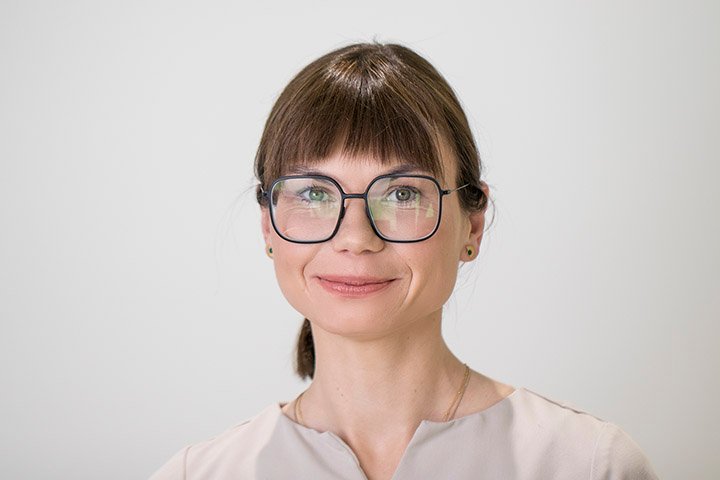
Rūta Minkevičienė | Pediatric dentist
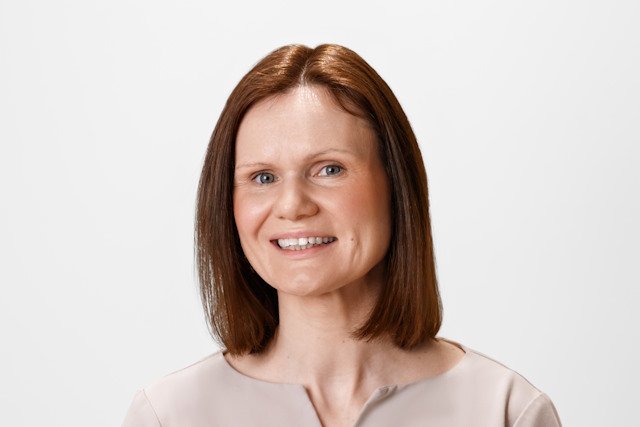
Agnė Grigelionienė | Pediatric dentist
Completed works
Pediatric dentistry near me – get to know the work done by our dental clinic professionals and patient stories:
01
Pediatric dentistry
The patient is 3.5 years old. The mother wanted the child’s teeth to look aesthetically pleasing. The front baby teeth were filled with composite.

02
Pediatric dentistry
Standard stainless steel dental teeth crown. The patient is 2 years old. The crown was chosen because in this situation (the tooth is incompletely grown, the damage is extensive) the conventional filling may crumble over many years, due to non-compliance with the diet and dental hygiene plan, there is a chance of repeated caries. With a dental teeth crown we can provide protection against that and there is a greater chance that the tooth will last as long as needed (a permanent tooth grows in this place at 10-11th year of life).

03
Pediatric dentistry
The patient is 3.5 years old. Mom wanted the front teeth to be beautiful. An example of zirconium. The last photo was taken after 1.5 years have passes.

04
Pediatric dentistry
Another example of two adjacent crowns. The patient is 5 years old. Teeth are not brushed at home. Caries is active, molar milk teeth are damaged on almost all surfaces. Standard stainless steel crowns were chosen so that repeated decay does not occur due to bad hygiene and dietary habits, so that conventional fillings that cannot withstand the load would not crumble over many years.
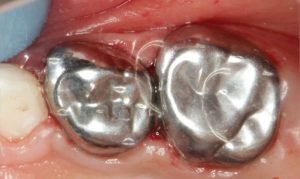
05
Pediatric dentistry
Similar to case 2. Young age, the tooth is damaged by active caries. A long-term solution is needed.
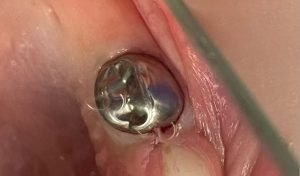
First visit to the pediatric dentist
/ Introduction to a dentist should already happen after the first milk teeth have erupted. This will most likely not be a treatment – it will only be an examination and familiarization with the dentist’s chair, the environment and your doctor.
/ In order to make the visit pleasant and leave a good impression on the child, the pediatric dentist always tries to speak calmly, take into account the child’s wishes, not cause any pain during the examination and not take long. It is very nice if a sister or brother comes to the examination together, then the visit becomes more fun and the child does not have time to think about unpleasant sensations. Often, after the visit, the child is rewarded with a toy for endurance.
/ The first visit to the dentist is the most important, so not only the doctor, but also the parents play a big role. Regardless of how the pediatrician will try to calm the child down or tell him everything, if the child came to the clinic because of a punishment (“if you don’t brush your teeth, we’ll take you to the doctor, and then it will hurt!”) or all the time at home heard you saying “it really won’t hurt”, then the visit will be unpleasant and the initial attitude of the child will be hostile or fearful. Before the visit, parents should not talk about the pain (or no pain) experienced in the dentist’s office. The child only goes for an examination or teeth cleaning.
It is important to find a good pediatric dentist
/ A good pediatric dentist never scares or intimidates a child. The experience in the dentist’s chair determines the future attitude of both the child and the adult towards dentists and general oral care. Regardless of whether it is the first visit or the tenth, the children’s dentist is always attentive, gentle and respects the wishes of both the child and the parents.
/ A good specialist will never mention pain to the child and will never try to force the child to do something through the prism of fear.
/ If it is difficult to find a common language with the child or he or she is afraid and does not let the doctor to come close, then there is always a way out – pediatric dentistry with sedation. You should never be afraid of this choice, because oral and dental diseases can be much more harmful than treating a child’s teeth under general anesthesia.
Prices
Prices of the most popular services:
69 €
39 €
Financing options
Dental prosthetics and its cost: the price of this procedure can always be friendly to our patients. For those who cannot pay the full amount at once, we offer to pay for the treatment in parts. Our partners Inbank will help you to cover dental bridges cost, teeth crowns cost and purchase the dental prosthetics service in installments.
Other possible financing options:
/ Billing with health insurance funds when the patient has concluded a contract with the insurance company.
/ Funding from territorial health insurance funds for patients covered by mandatory health insurance.
Sedation as a help to treat children's dental diseases
/ Common dental diseases in children require serious treatment – drilling, filling, extraction or even permanent dentures in older age. There is never a right time to treat a tooth and it is usually done only when there is an injury or decay and pain. Unpleasant experiences do not give the child any confidence while being in the dentist’s office. In such cases, children’s teeth treatment with anesthesia – sedation helps.
/ Children’s dental treatment with sedation is a completely harmless and common procedure. In elderly people or those with heart disease, full sedation can have negative consequences in some rare cases (impaired short-term memory, heart failure), but this probability is almost zero for children. Of course, sedation is only used in exceptional cases for children who are seriously ill, allergic to anesthetics or have a high fever.
/ Along with the children’s dentist, there is also an anesthesiologist in the office, who monitors the child’s condition during the treatment. The child’s vital parameters are always watched on the monitor, and an oxygen machine is ready nearby in case the child begins to have difficulty breathing. After the treatment, the child wakes up within 10 minutes and is discharged home after an hour. Full recovery takes an hour, during which doctors are nearby, ready to provide any assistance.
Read full details: Sedation and narcosis (general anesthesia).
Do you need to protect milk teeth?
It is necessary to protect milk teeth. When milk teeth are damaged, root inflammation occurs, the abscess damages the permanent teeth below and the latter erupt unhealthy.
Both milk and permanent teeth are formed before the child is born. Permanent teeth are formed in the jaw under milk teeth, so their contact is inevitable. A broken or damaged milk tooth harms the development and eruption of a permanent tooth. It is especially dangerous if an injury occurs during which milk teeth are displaced – then you need to urgently contact a children’s dentist to check whether permanent teeth are damaged and their direction changed.
Sometimes, in order to save a permanent tooth, it is necessary to urgently remove a milk tooth if it is too crooked or sunk in.
At one time, a child has 48 teeth. When baby teeth have erupted, permanent teeth have also already formed in the jaws, i.e. the child has 20 milk and 28 permanent teeth.

Dental sealants - what are they?
/ On the contrary – just erupted permanent teeth are very vulnerable due to porous enamel, which mineralizes in 1-2 years. Therefore, it is recommended to cover the first molars with sealants only after they have erupted, i.e. when the child turns 5-7 years old.
/ Dental sealants for children are not new (they are more widely used in the world for over 50 years) and there are many studies that confirm their benefits. Even 8 years after sealing your teeth, the chance of tooth decay is reduced by 80-90%.
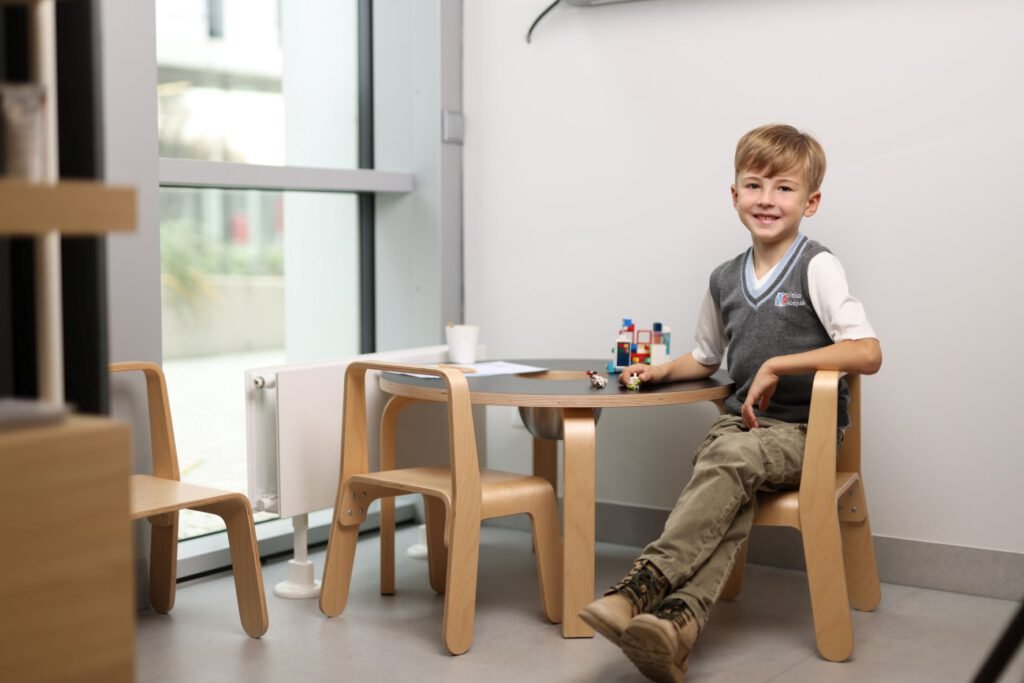
/ Permanent teeth have small grooves where plaque and food debris accumulate. Regardless of how well parents clean their children’s teeth, due to the anatomy of a young tooth, food can get stuck in the grooves and create a medium for caries to spread. Therefore, after the first molars have erupted, you should visit a pediatric dentist, who will examine the condition of the teeth, clean the accumulated dirt and apply sealants. Sealants are placed only after making sure that the grooves are clean and that there are no dirt left in them that could damage the tooth while under the sealant.
/ After covering children’s teeth with sealants, you can expect that they will not wear down for about a year. It is possible to renew later, but usually only the material on the surface wears off, and it can remain in the grooves for another nine years! We cover the first molars with sealants when they have just erupted, at the age of 5-7 years, and after the eruption of the second row of molars – at the age of 11-13. Dental sealants strengthen the protective function of a child’s tooth until it is fully mineralized and resistant to caries. Caring for sealed teeth is no different from normal oral hygiene – brushing with a toothbrush twice a day, care with interdental floss and a single-tooth brush or oral irrigator are recommended.
How to take care of children's teeth?
It is a myth that you should not use toothpaste with fluoride.
It’s a myth that you shouldn’t brush the teeth with a toothbrush.

Children’s dental care starts with the first milk tooth.
/ Children’s toothpastes contain very little fluoride, and when it is swallowed, the body absorbs it perfectly and the mythical “poisoning” which people usually talk about does not occur. The daily fluoride intake norm for an adult is about 0.5 mg, and for a child it’s 1.4 mg. We usually get enough of it from drinking water.
/ Harmful dose of fluoride for a small child is about 1-2 g, i.e. you should eat about 30 tubes of toothpaste. Such a quantity is hard to imagine being swallowed at one time. Therefore, for cleaning children’s teeth, use a toothpaste with fluoride, which has a concentration of at least 500 ppm. It should be remembered that children from the age of two can already spit out the paste themselves. After brushing the teeth, you should rinse the mouth a little, but do not overdo it, because the remaining part of the paste in the mouth perfectly protects teeth during sleep.
The professional team of doctors at our dental clinic works for the health of your teeth!
